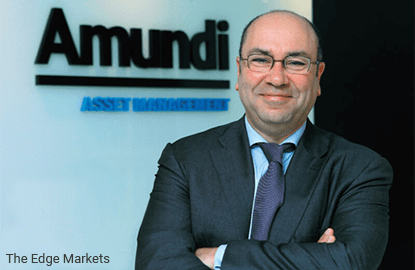
AT the 2015 United Nations Climate Change Conference in Paris (also known as COP21), 195 countries pledged to limit global warming to less than 2°C. Unlike previous commitments, the accord not only involved governments but also increased pressure on companies and investors to embrace low-carbon investing strategies.
Institutional investors, such as pension funds and university endowments in mature economies, have already implemented low-carbon strategies. Those in Asia are not far behind, says Frédéric Samama, deputy global head of institutional and sovereign clients at Amundi Asset Management.
China is taking the lead in this initiative, says Samama. The world’s second largest economy unveiled plans last year to halt the rise of greenhouse gas emissions and increase the amount of energy the country generates from renewables. Combined, the US and China account for about 40% of global emissions.
“The country will host the G20 Hangzhou summit in September and there is special attention on climate change. Its 13th Five-Year Plan was announced months ago, with climate change as a key component,” says Samama.
According to him, China is en route to becoming the biggest “green investor”, referring to the amount it expects to invest in renewable energy infrastructure in the near future. The country is determined to reduce its carbon intensity by 60% to 65% by 2030, generating 20% of its electricity from non-fossil sources by 2020 and to peak its emissions by 2030.
Ma Jun, chief economist at the research bureau of the People’s Bank of China (PBC), who heads the green finance committee, announced in June that it has identified investment opportunities worth RMB6.6 trillion (RM4 trillion) in low-carbon buildings, green transport and clean energy in Chinese cities by 2020.
“[According to the analysis of the green finance committee], the Chinese government can only fund 10% to 15% of the needed investment. New private ‘green’ capital will be required to underwrite the delivery of these ambitious targets, so China wants to mobilise its pension market,” says Samama.
If more governments and institutions get on board, the domino effect created by the Paris accord could be one of the greatest changes the global economy has ever seen, he adds. “The Chinese authorities want risk analysis, risk transparency, low-carbon indices, green bonds and so on. My strong belief is that, yes, it all started in Europe but it will shift to Asia soon, with China taking strong leadership.”
Before the climate change pact was inked, it was nearly impossible to convince institutional investors of sustainable investment strategies, mainly because they are often obligated to follow a pre-determined benchmark, particularly when paying out dividends, says Samama.
“Before this, when we talked about climate change to investors, the message was about serving the planet. But to investors, this was not their job. They would express their concerns about climate change, but also say it was up to the governments and non-governmental organisations. Their job is to invest and make returns to be able pay something to their pensioners. In the case of insurance companies, they must be able to pay policyholders,” he adds.
The root cause of this belief is that climate change is a purely altruistic move that goes beyond standard investment horizons, complex renewable energy market and the lack of measurable investment solutions, says Samama. “The problem with climate change-related risks is that you do not when or how big they are. If you don’t know when this problem will materialise, it is super complicated for investors to take action.”
Data-driven studies have shown that sustainability aligns the world’s long-term future with the interests of asset managers. This can be seen in the coming together of the world’s largest asset owners under the umbrella of the Portfolio Decarbonisation Coalition and pledging to reduce carbon emissions associated with US$600 billion of assets.
With this mind, the Fourth Swedish National Pension Fund (AP4) — Fonds de Réserve pour les Retraites — and Amundi worked with MSCI to develop new low-carbon equity indices, similar to the MSCI’s indices but comprising companies with significantly lower carbon exposure than the broader market.
Last year, Amundi launched an exchange-traded fund (ETF) that tracks the MSCI World Low Carbon Leaders index, encouraging institutional investors to decarbonise US$100 billion of investments worldwide. Among the top holdings of the Amundi Index Equity Global Low Carbon are companies such as Apple Inc and Microsoft Corp.
“The solution we have brought is super simple and straightforward. Most investors are already investing in low-carbon indices, be it MSCI, FTSE or STOXX, and within these indices, you have companies that are exposed to climate change,” says Samama.
“Even by investing passively, you are taking an active risk on climate change. So, we took an index and made a ranking of all the companies, depending on their exposure to taxation on pollution or because they are exposed to stranded assets. We made a ranking of all companies based on these two criteria and we excluded the most exposed companies.
“The MSCI Low Carbon Leaders exposures allow investors to reduce carbon risk while maintaining a sectorial and geographical exposure similar to the parent indices. With this, a new messaging took place about climate change — that in the end, it is a risk management problem and has a lot to do with gearing up against worst-case outcomes.”
Amundi’s target was an ambitious one when it launched the index. It got asset owners to make a commitment to decarbonise up to US$100 billion. But by COP21, it had managed to get the backing of 25 asset owners committed to decarbonising their portfolios worth a total asset value of US$3.2 trillion.
“With this, investors’ issues with the investment horizon has been resolved. The complexity of the market has been resolved and the problem of scalability has also been resolved. This is a pragmatic approach,” says Samama.
Save by subscribing to us for your print and/or digital copy.
P/S: The Edge is also available on Apple's AppStore and Androids' Google Play.